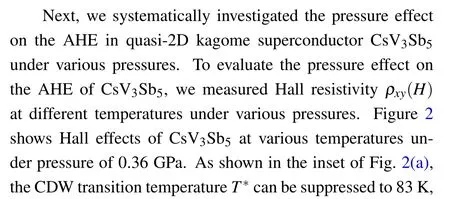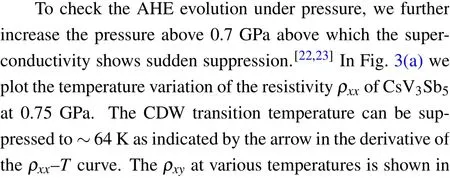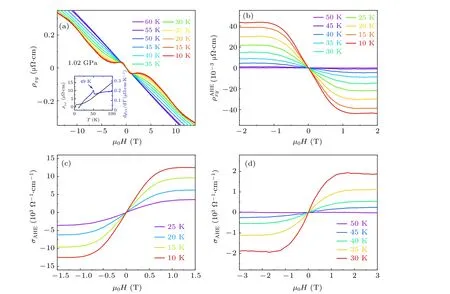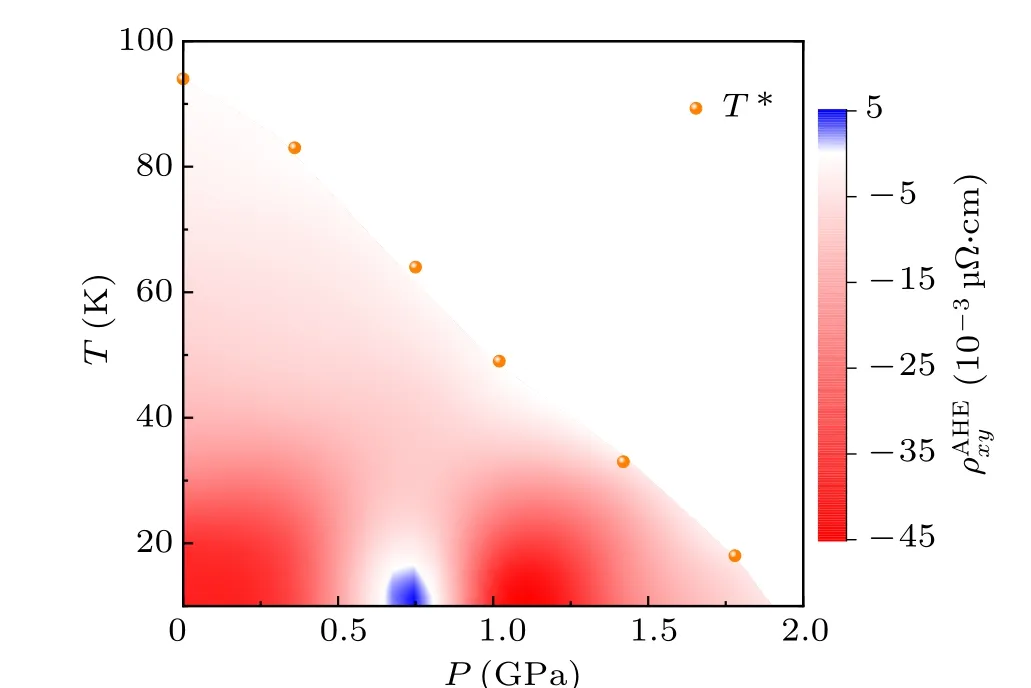Pressure tuning of the anomalous Hall effect in the kagome superconductor CsV3Sb5
2022-01-23FangHangYu喻芳航XiKaiWen温茜凯ZhiGangGui桂智刚TaoWu吴涛ZhenyuWang王震宇ZiJiXiang项子霁JianjunYing应剑俊andXianhuiChen陈仙辉
Fang-Hang Yu(喻芳航) Xi-Kai Wen(温茜凯) Zhi-Gang Gui(桂智刚) Tao Wu(吴涛) Zhenyu Wang(王震宇)Zi-Ji Xiang(项子霁) Jianjun Ying(应剑俊) and Xianhui Chen(陈仙辉)
1Hefei National Laboratory for Physical Sciences at Microscale and Department of Physics,and CAS Key Laboratory of Strongly-coupled Quantum Matter Physics,University of Science and Technology of China,Hefei 230026,China
2CAS Center for Excellence in Quantum Information and Quantum Physics,Hefei 230026,China
3Collaborative Innovation Center of Advanced Microstructures,Nanjing 210093,China
Keywords: anomalous Hall effect(AHE),charge-density-wave(CDW),kagome superconductor,pressure effect
1. Introduction
The anomalous Hall effect (AHE), which occurs due to an “anomalous” transverse group velocity of carriers, has been one of the most attractive transport phenomena in the condensed matter physics since its experimental discovery more than a century ago.[1]In general, the AHE can be broadly engendered by two classes of mechanisms: the extrinsic and the intrinsic ones. The extrinsic mechanism owes to spin-dependent impurity scattering effects,including skewscattering(ρxy∝ρxx)and side jump(ρxy∝ρ2xx).[2,3]The intrinsic mechanism governed by the electronic structure of a material is related to the nonzero Berry curvature(ρxy∝ρ2xx),[4-7]which is the dominant mechanism in topological materials like Co3Sn2S2,[8]ZrTe5[9]and GdPtBi.[10]On the other hand,the AHE can be divided into three regimes by the magnitude of conductivityσxx: dirty limit (σxx<104(Ω·cm)-1), intrinsic dominant (104(Ω·cm)-1<σxx<106(Ω·cm)-1) and clean limit(σxx>106(Ω·cm)-1).[1-3,11,12]
Recently, a new family of topological kagome metalsAV3Sb5(A= K, Rb, Cs) have attracted great attention due to their abundant physical properties.[13]These materials possess a layered hexagonal centrosymmetric structure with space groupP6/mmm(No. 191). There are two kinds of Sb sites.The vanadium sublattice in the V-Sb1 layers forms an ideal 2D kagome network, and the Sb2 atoms locate between the kagome hexagons and the alkali-metal layers as shown in Fig. 1(a). Interestingly, these compounds show superconductivity with the superconducting transition temperatureTC=0.93 K, 0.92 K, 2.5 K forA= K, Rb, Cs, respectively.[14-17]In addition, a charge density wave (CDW) order appears below a transition temperature 78-105 K across the three compounds.[13,14,16]Furthermore, unconventional giant AHE was observed in the nonsuperconducting K1-xV3Sb5and superconducting CsV3Sb5with the absence of magnetic order or local moments.[18,19]More interestingly, a strong correlation between the AHE and CDW state was revealed in CsV3Sb5,[19]which may associate with the unconventional chiral charge order.[20,21]However, the origin of the AHE is still a mystery.
Since the CDW state and the AHE in CsV3Sb5are intimately correlated, it is desirable to further manipulate the AHE and to investigate their relationship. In this regard,pressure can be employed as a clean and effective means, especially for the materials with abundant physical properties like CsV3Sb5. In fact,unusual competition between CDW and SC under pressure was reported previously.[22,23]A new CDW order is suggested to appear above 0.7 GPa,[22,23]which may strongly suppress the superconductivity. More interestingly,a new superconducting dome emerges above 15 GPa without CDW order.[24-27]However, despite a large number of highpressure works on CsV3Sb5, there is no systematic study of the AHE under pressure so far. In addition,many experimental observations of high pressure modulated AHE have been reported in the other topological materials.[28-35]In this paper,we have tuned the giant AHE in CsV3Sb5by applying hydrostatic pressure.We confirm that the AHE is strongly correlated with the CDW order even under pressure. In addition,a positive anomalous Hall resistivity signal suddenly emerges below 35 K at 0.75 GPa,which could be related to the Fermi surface reconstruction and/or Fermi energy shift under pressure. Our work demonstrates that CsV3Sb5provides us an ideal platform to study the correlation between AHE and CDW in the kagome lattice system.
2. Methods
The CsV3Sb5single crystals were grown using a self-flux method similar to the previous reports.[14]In order to prevent the reaction of Cs with air and water, all the preparation processes were performed in an argon glovebox. After reaction in the furnace, the as-grown CsV3Sb5single crystals are stable in the air. The excess flux was removed using ethanol and millimeter-sized single crystal can be obtained. XRD data were collected at room temperature by using an x-ray diffractometer (SmartLab-9, Rikagu) with CuKαradiation. Electrical transport measurements were carried out in a Quantum Design PPMS-14T system. The longitudinal resistance and Hall resistance were simultaneously measured with standard six-probe Hall bar geometry. Hydrostatic pressure was established in a piston-cylinder cell (PCC) with Daphne 7373 oil used as the pressure transmitting medium. The pressure values in PCC were calibrated by measuring the superconducting transition temperature of pure tin.

Fig.1. Crystal structure of CsV3Sb5. The Cs,V,Sb1 and Sb2 atoms are presented as blue,green,puce and hazel balls,respectively. The vanadium sublattice forms perfect kagome lattice. (b)Single-crystalline x-ray diffraction pattern for the CsV3Sb5 single crystals. All the peaks can be well indexed with Miller indices(00l). (c)Temperature dependence of resistivity at ambient pressure.The arrows denote the CDW transitions at ~94 K.The inset indicates the superconducting transition around 2.7 K.
3. Results and discussion
We first checked the quality of the as-grown CsV3Sb5single crystals under ambient pressure, with results summarized in Fig.1.Figure 1(b)displays the x-ray diffraction(XRD)pattern of a CsV3Sb5single crystal. Only(00l)diffraction peaks can be detected which indicates the as-grown single crystal having a (00l) preferred orientation. The lattice constantcis 9.308 ˚A,being consistent with previous report.[13]Figure 1(c)displays the temperature dependence of resistivity of the sample at ambient pressure which showsTCaround 2.7 K. The residual resistivity ratio (RRR)is 61, suggesting high quality of the sample. The kink around 94 K in the resistivity curve is associated with the CDW transition,similar to the previous result.[14]


Fig. 2. Hall effects of CsV3Sb5 at 0.36 GPa. (a) The Hall resistivity as a function of field at various temperatures from 10 K to 100 K. The inset shows the temperature dependence of resistivity. T* is suppressed to 83 K as determined from the derivative resistivity curve. (b) The extracted anomalous Hall resistivity taken by subtracting the local linear ordinary Hall background at various temperatures from 10 K to 90 K.AHE spontaneously emerges below T*. (c)and(d)The extracted anomalous Hall conductivity at various temperatures.



With further increasing the pressure,T*can be suppressed to 49 K at 1.02 GPa as shown in the inset of Fig.4(a).The Hall effect measurements at various temperatures are shown in Fig. 4(a).ρxyshows different behavior with that at 0.75 GPa at low temperature, which indicates that the Fermi surface may be rather sensitive to the pressure. The highfield nonlinear behavior ofρxyis related to the two-band ordinary Hall effect, which is similar to the ambient-pressure results.[18,19]The extractedρxydecreases with increasing temperature and persists up to the CDW transition temperatureT*as shown in Fig. 4(b). Similarly, the magnitude of the AHE monotonically decreases with increasing temperature until it is lost at aroundT*as shown in Figs.4(c)and 4(d). We notice that the positive anomalous Hall resistivity disappears,which is possibly due to the shift of the Fermi energy under pressure.

Fig.3. Hall effects of CsV3Sb5 at 0.75 GPa. (a)Temperature dependence of the resistivity ρxx and the derivative resistivity dρxx/dT. The CDW ordering temperature is indicated by arrows as T* ~64 K.(b)Field dependent Hall resistivity ρxy at various temperatures from 10 K to 70 K.(c)and(d)The extracted anomalous Hall resistivity taken by subtracting the local linear ordinary Hall background at various temperatures from 10 K to 70 K. AHE spontaneously emerges below T*. A positive anomalous Hall resistivity emerges below 35 K.(e)and(f)The extracted anomalous Hall conductivity at various temperatures.

Fig.4. Hall effects of CsV3Sb5 at 1.02 GPa. (a)The Hall resistivity at different temperatures. The inset shows the temperature dependence of resistivity and the derivative resistivity curve with a kink at T* ~49 K.(b)The extracted anomalous Hall resistivity at various temperatures from 10 K to 60 K.AHE spontaneously emerges below T*. (c)and(d)The extracted anomalous Hall conductivity at different temperatures.
Further increasing the pressure,T*can be gradually suppressed. With pressure increasing to 1.78 GPa,T*can be suppressed to 18 K as shown in Fig. S1 in the supplementary materials. The AHE also appears belowT*. By completely suppressingT*above 2 GPa, AHE disappears.[19]Combing all the high-pressure Hall measurements, we can map out the phase diagram of CsV3Sb5as shown in Fig. 5. The CDW is monotonically suppressed by elevating the pressure, and disappears at~2.0 GPa. The negative Hall resistivity persists up to the CDW transition temperatureT*even under pressure. Remarkably, the amplitude of the anomalous Hall resistivity suddenly decreases around 0.75 GPa,which is due to the abrupt emergence of the positive anomalous Hall resistivity. Such behavior can be strongly correlated with the new CDW order that develops above 0.7 GPa which will be detailed discussed below. At the meantime,the AHC also shows local minimum around 0.75 GPa, as shown in Fig. S2 in the supplementary materials.struction, which could be one of the possibilities for the origin of the positive anomalous Hall resistivity. Such intrinsic AHE can be weakened when the Fermi energy slightly shifts at higher pressure.However,we can not figure out which band contributes to the intrinsic AHE from the current measurements.The band structure measurements are crucial to answer this question, though such measurements are rather difficult under pressure. Recently, the AHE is found to be tunable through proton intercalation in the CsV3Sb5nanoflakes.[36]Peculiarly, the AHE change sign when the carrier is tuned from hole to electron,[36]similar to our high-pressure results.We propose that the AHE at ambient pressure is constituted by both extrinsic and intrinsic origins,by change the pressure,the Fermi energy shift may lead to the sign change of the intrinsic part of the AHE around 0.75 GPa. With further shifting the Fermi energy,the intrinsic AHE gradually vanishes and the extrinsic AHE dominates at higher pressure.

Fig. 5. The 2D color contour plot of the anomalous Hall resistivityas a function of P and T.Positiveemerges around 0.75 GPa whichis possiblydue totheFermisurface reconstruction or/and Fermi energy shift when the new CDW order develops.
4. Conclusion
We systematically investigated the pressure effect of the AHE in CsV3Sb5. Our high-pressure transport measurements confirm the concurrence of AHE and CDW in the compressed CsV3Sb5. In addition, we observed that positive anomalous Hall resistivity emerges below 35 K at 0.75 GPa, such behavior can be attributed to the Fermi surface reconstruction and/or Fermi energy shift under pressure. Our results demonstrate that the intrinsic AHE in CsV3Sb5can be easily tuned,making CsV3Sb5an ideal platform to study the AHE and its correlation with CDW order.
Although the origin of the AHE in CsV3Sb5is not well understood, our work unambiguously demonstrates that the negative anomalous resistivity immediately sets in belowT*,which indicates the intimate correlation between AHE and CDW. More interestingly, we observed a positive anomalous Hall resistivity emerges below 35 K at 0.75 GPa.The origin of AHE can be either intrinsic or extrinsic. Since the pressure is unlikely to sudden change the impurity, therefore, the extrinsic AHE should not change much under pressure.The intrinsic AHE is rather sensitive to the band structure and Fermi energy,both of them may be dramatically changed under pressure and could be the origins of the unusual AHE evolution under pressure. Previous high pressure works demonstrated that a new CDW order develops above 0.7 GPa, which would strongly suppress the superconductivity and lead to the intriguing twodome superconductivity behavior.[22,23]The formation of the new CDW would naturally lead to the Fermi surface recon-
Acknowledgments
This work was supported by the National Key Research and Development Program of China (Grant Nos. 2019YFA0704900 and 2017YFA0303001), the Anhui Initiative in Quantum Information Technologies (Grant No. AHY160000), the Science Challenge Project of China(Grant No. TZ2016004), the Key Research Program of Frontier Sciences, Chinese Academy of Sciences (CAS)(Grant No. QYZDYSSWSLH021), the Strategic Priority Research Program of the Chinese Academy of Sciences (Grant No. XDB25000000), the National Natural Science Foundation of China (Grants Nos. 11888101 and 11534010), the Collaborative Innovation Program of Hefei Science Center,CAS (Grant No. 2020HSC-CIP014), and the Fundamental Research Funds for the Central Universities, China (Grant No.WK3510000011).
猜你喜欢
杂志排行
Chinese Physics B的其它文章
- Superconductivity in octagraphene
- Soliton molecules and asymmetric solitons of the extended Lax equation via velocity resonance
- Theoretical study of(e,2e)triple differential cross sections of pyrimidine and tetrahydrofurfuryl alcohol molecules using multi-center distorted-wave method
- Protection of entanglement between two V-atoms in a multi-cavity coupling system
- Semi-quantum private comparison protocol of size relation with d-dimensional GHZ states
- Probing the magnetization switching with in-plane magnetic anisotropy through field-modified magnetoresistance measurement
